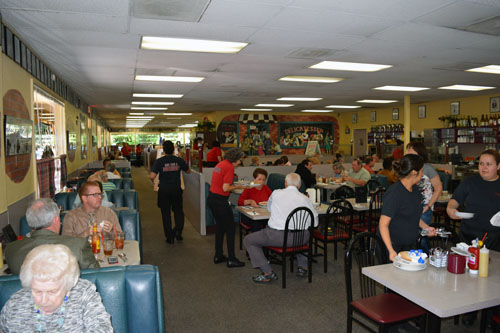
–37th in a series —
Exit 11: Lake Murray/ 70th Street Exit, San Diego/ La Mesa, California ~ D.Z. Akin’s Deli
By Donald H. Harrison

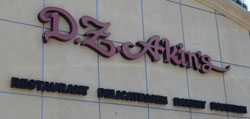 SAN DIEGO—Thanks to a chopped liver recipe and some bold flirting, San Diego has in D.Z. Akin’s one of the county’s most popular Jewish delis. Created in 1980 by Zvika and Debbie Akin, the eatery expanded in increments from a 48-seat deli to a 225-seat restaurant, bakery, catering company and gift shop. So often did D.Z. Akin’s take over the floor space of a next door neighbor at the shopping center at 6930 Alvarado Road, it could be thought of as “the restaurant that ate San Diego.”
SAN DIEGO—Thanks to a chopped liver recipe and some bold flirting, San Diego has in D.Z. Akin’s one of the county’s most popular Jewish delis. Created in 1980 by Zvika and Debbie Akin, the eatery expanded in increments from a 48-seat deli to a 225-seat restaurant, bakery, catering company and gift shop. So often did D.Z. Akin’s take over the floor space of a next door neighbor at the shopping center at 6930 Alvarado Road, it could be thought of as “the restaurant that ate San Diego.”
It all started in the late 1970s when Debbie Epstein, who grew up at Tifereth Israel Synagogue in San Diego and moved to Los Angeles to attend UCLA and live with her aunt, was working as a representative for her family’s wholesale clothing business. Based at the California Clothing Market in downtown L.A., she called upon men’s stores to sell to them shirts, belts, ties, and sportswear. Her aunt noticed that near the intersection of Pico and Overland at G&L Kosher Meats worked a young, single butcher, Zvika Akin, who had immigrated as a teen-ager from a village outside Jaffa, Israel. Check him out, she advised Debbie.
So Debbie did, her pretext being that she wanted to purchase a kosher chicken. Zvika asked if she wanted the giblets too, to which Debbie replied she wasn’t sure about the giblets but she wished that there was enough liver in that chicken for her to prepare one of her favorite recipes.
Quick on the uptake, Zvika offered to throw in some extra chicken livers if she would let him taste her creation. That was on a Friday, and the following Monday, Debbie brought some chopped liver for him to sample. He loved it, and she later confided, “It’s all in the fried onions. That is what makes it delicious. Most delis don’t bother to fry the onions.” Today, Debbie’s chopped liver is one of hundreds of items on the menu of D.Z. Akin’s, popularly known as deezee’s
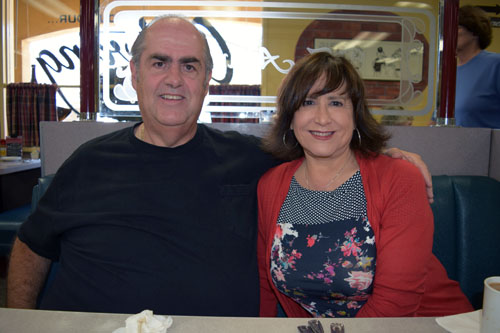

Debbi and Zvika were married in 1977 by Rabbi Aaron Gold of Tifereth Israel Synagogue. After Zvika’s rent at the Los Angeles butcher shop was raised $1,000 per month by a lawyer who purchased the property, he decided to sell the business. The couple then decided since Debbie could cook and Zvika knew his meats, maybe they should consider opening a delicatessen. Having no background in the restaurant business, they visited all the well-known delis in Los Angeles, asking for advice, and checking out the pricing on their menus.
The advice was not positive. “Don’t do it, you don’t know what you are talking about, you are two stupid kids—that was basically the advice that we got,” remembered Debbie. “Honestly,” said Zvika, “they were not very far from the truth. Honestly, other dummies would never have made it.”
“Nine out of 10 restaurants go out of business,” Debbie said. “Of the ten that stay in business most just make a living.”
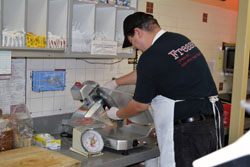
Although Debbie’s parents, Bernie and Ethel Epstein and her brother, Steven, were initial investors, after three months of no profits in 1980, they thought they saw the handwriting on the wall and declined to invest any more money. “We had to come up with the money ourselves,” remembered Debbie. “Had Zvika’s father not passed away in Israel, we would not have had any more money to put into it and we would have gone out of business, just like the rest of the world.”
So they kept at it, seemingly 24 hours a day, setting up in the storeroom an area for their infant son Neil’s crib, so they could work at the restaurant night and day.
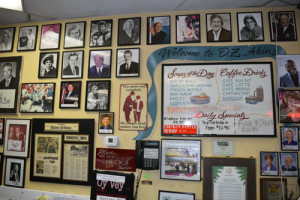
Growth was not planned; from the original idea of a take-out deli, the restaurant began to evolve in their minds. “If they wanted a pound of corned beef and they wanted to sit down and have a corned beef sandwich, we could put in a couple of tables and let them have a table there,” Debbie recalled thinking. “From that, it was what if they wanted corned beef and eggs? Well, we’ll make corned beef and eggs. What if they wanted something else?”
“Even though we knew nothing,” interjected Zvika.
“We knew nothing. I wasn’t a waitress. He wasn’t a cook,” said Debbie, smiling at her business partner and ex-husband from whom she has been divorced since 2008. “But the restaurant just evolved. We created a monster, we had no idea what we were doing.”
Well, what was it that they were doing wrong at first? I asked
“Everything!” said Zvika.
“The one thing we were was good cooks, but knowing how to cook, and knowing when to hold and when to throw away, and to please the customer yet stick to the plan of the menu and not allowing yourself to be manipulated, because you have to stay consistent, all that was difficult. And then, managing employees, not letting them run all over you, dealing with personalities. It was just growing pains, what we did in our first couple of month versus now. I have to tell you, it is easier now with 150 employees, than it was with three. It is so consistent. Now we can practically do it with our eyes closed in comparison to what it was then.”
In the first expansion, D.Z. Akin’s went from 48 seats to 100; in the second from 100 to 150; and in the third from 150 to 225. Next came a gift shop. And eventually the Akins purchased the entire strip mall, including the building across the parking lot. They make certain to rent to businesses that don’t require a lot of parking, so restaurant patrons don’t have to compete against their tenants.
Zvika said it was only after the second expansion, to 150 seats, that the restaurant began to make some money. The reason, he explained, is with greater sizes, the restaurant could make greater economies.
“People think this is a gold mine,” said Debbie, “but in fact it is a very difficult business.”
She said that whereas a steak restaurant can mark up the price of its steaks at a high margin; patrons would never pay such amounts for delicatessen sandwiches and platters. So, Akins has to work within a certain price point. To open potential new profit streams, the restaurant expanded into catering, carry-out delicatessen, carry-out bakery and a gift shop. Debbie says she calls the gift shop “our bar. At other restaurants when you have to wait for seats, you can go to the bar. Here, people go to the gift shop.”
The secret for the restaurant’s popularity, the Akins agreed, was “persistence and consistency.”
“I had only one goal, that the customers left with smiles on their faces and rubbing their tummies and saying, ‘My God, that was delicious’ – like they were coming over for dinner to my house. I never thought about money. To this day, I don’t think about money.”
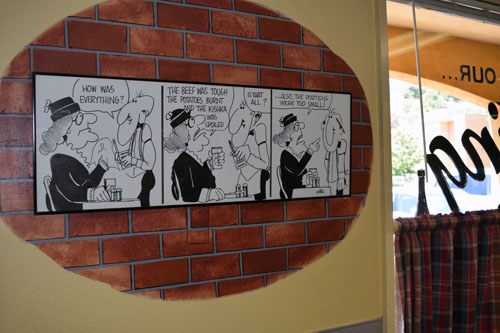
“Smiles on their faces” may also explain some of the accoutrements in the restaurant. The wait staff wear T-shirts with Yiddishisms. The wall is covered with pictures of celebrities who have eaten in the restaurant and with cartoons by Ivan Goldstein, who used to publish them in Israel Today which metamorphosed into the now defunct San Diego Jewish Times. The cartoons transmit some Yiddish restaurant humor, which sometimes consists of customers complaining and waiters responding with a snappy come-back.
Debbie said the cartoons capture the Jewish flavor of DZ Akin’s – even though its customer base has been changing. Once perhaps 90 percent Jewish, only about 50 percent of the customers today are Jews – a reflection of changing demographics of the surrounding Lake Murray and La Mesa areas as well as the growing popularity of Yiddish culture among non-Jews, Debbie said.
Which brought to mind two of Debbie’s favorite stories about the deli, which serves kosher-style meats as well as non-kosher meats.
“My favorite is the lady who yelled at me. She called up and yelled that we need to put a disclaimer on our clam chowder soup because we put bacon in it, and bacon is not kosher. How dare we serve clam chowder with bacon!”
The woman hung up before Debbie could explain that clam chowder is also non-kosher.
Another lady called before Passover to make certain that D.Z. Akin’s served matzo with its meals. Debbie assured the lady that, in fact, they are happy to put matzo alongside a helping of meats, or any other entrée, if that was desired. The woman was very happy, so happy in fact that she smothered Debbie with kisses when she came in, telling her how wonderful she was to have matzo on hand.
“Later on, I walked by her table, and saw she had bacon and eggs with a side of matzo! It’s everything you can do not to laugh sometimes.”
I asked when the Akins realized that their restaurant was here to stay and that they finally had made it.
“There is a thing called the Restaurant Association Awards,” recounted Debbie. “It is like 1,000 people, and back in the 1990s we were up for ‘Best Breakfast’ and we won! And I’ve always been the one who has been pushed to the front because he (Zvika) is shy, so he pushed me, and I said ‘you better be behind me because we are going to accept the award, and it was Jack White (a television broadcaster) who was giving out the awards. I was a nervous wreck. I almost didn’t want to win the award because I would have to get up before 1,000 people and give a speech, yet. He pushed me and we got up there, and I was stunned. He (White) gives me the award, and the first thing I say is ‘well, I guess I better become a member of the Restaurant Association’ and the audience died laughing, thank God. It broke the ice. Then when we left, the Ghios (long-established restauranteurs) of Anthony’s, and others were coming over to us, like we won the Academy Award, we couldn’t believe it. People were coming up, congratulating us, saying ‘we love your restaurant,’ and these were all the people who are in the business. It was something else.
“And we got into the car, and he looks over to me and he says, ‘it’s a long way from Abu Kabir,’ his little shtetl in Jaffa, where he’s from. He is in his little Mercedes, he has his award, people are congratulating him, he was a super star, and that was the day I knew we arrived.”
Now thinking of eventual retirement and someday turning the business over to sons Elan and David (older son Neil went into the real estate business), the Akins were asked if they had ever considered opening delis in other parts of San Diego County, and cashing in on their popularity.
“We can hardly run this one,” said Debbie. “That is why you don’t really see chains of delis. It is a very hard business. The menus are so big.”
“So many items,” agreed Zvika. “Very difficult.”
“And as we are getting older, who wants that kind of stress? Elan and David think they would like to have another restaurant, but they have no idea,” said Debbie.
“They don’t know what they don’t know yet,” agreed Zvika.
“Exactly,” said Debbie.
*
From 70th Street exit, proceed north on Alvarado Road, which is the frontage road, and turn right into the DZ Akin’s parking lot.
Next: The synagogue that once was
*
Harrison is editor of San Diego Jewish World. You may contact him at donald.harrison@sdjewishworld.com or post your comment on this website provided that the rules below are observed.
__________________________________________________________________
Your comment should be followed with this information: Your full name, your city and state (or country) of residence. Letters lacking such information will be automatically deleted. San Diego Jewish World is intended as a forum for the entire Jewish community, whatever your political leanings. Letters may be posted below provided they are responsive to the article to which they are affixed, and civil in their tone. Ad hominem attacks against any religion, country, gender, race, sexual orientation, or physical disability will not be considered for publication. There is a limit of one letter per writer on any given day.
__________________________________________________________________